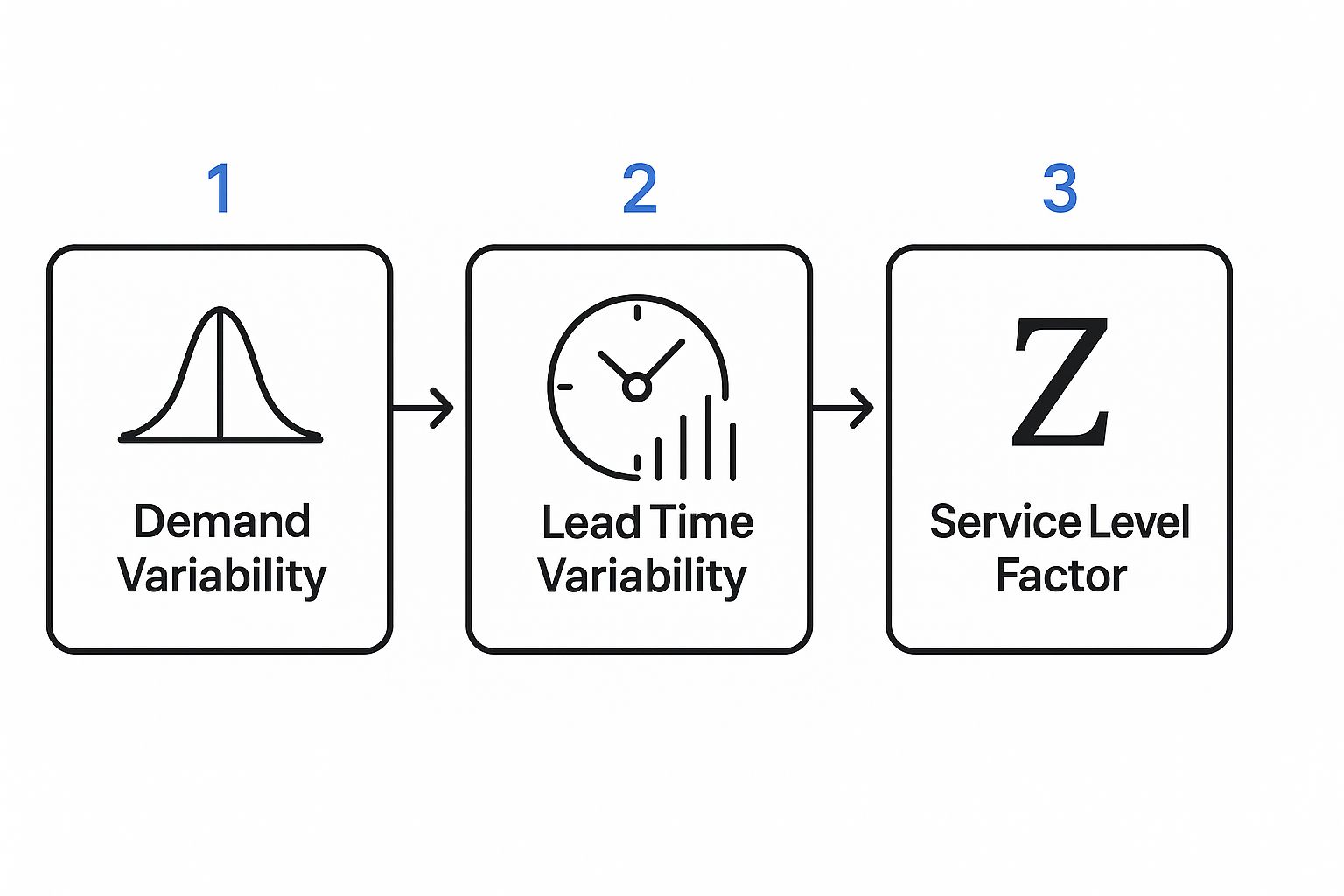Think of safety stock as your business's insurance policy against the unpredictable. It’s the extra inventory you hold on hand to prevent stockouts when customer demand suddenly spikes or a supplier’s delivery hits a snag.
Without this buffer, you're constantly one surprise away from losing sales, frustrating loyal customers, and throwing your entire operation into chaos.

Running an e-commerce brand is a perpetual balancing act. You need just enough product to satisfy demand but not so much that your cash is tied up in dusty, slow-moving inventory. This is where mastering safety stock stops being a tedious inventory task and becomes a core business strategy.
The whole point is to avoid the dreaded scenario of running out of stock (OOS), a situation that can do real damage to your brand's reputation and your bottom line.
Let's say you sell a popular line of skincare products. You wake up one morning to discover a top influencer with millions of followers just featured your best-selling serum in a viral video. Suddenly, orders are pouring in at 10 times your normal daily rate.
If you didn't have any safety stock, you'd sell out within hours. You’d be forced to slap a "Sold Out" notice on your site, disappointing thousands of eager new customers and completely fumbling a massive, unexpected revenue opportunity. All that momentum? Gone.
Now, imagine that same scenario, but with a well-calculated safety stock in place. The story plays out very differently:
This exact situation shines a light on the two main variables safety stock protects you from: demand uncertainty (unpredictable sales spikes) and lead time uncertainty (unexpected supplier delays).
Ultimately, knowing how to calculate safety stock gives you control. It transforms your inventory from a source of stress into a strategic asset. By building this buffer, you're not just stocking shelves; you're building resilience right into the foundation of your business, protecting your revenue, and making sure you can always deliver on your promises to customers—no matter what surprises come your way.

Before you even think about plugging numbers into a formula, you have to trust your data. It's a simple truth that a lot of people overlook: the accuracy of your safety stock calculation is only as good as the information you feed it. Garbage in, garbage out.
The entire process really boils down to four key data points. These numbers measure your past performance and volatility, and they're the foundation you'll build your entire inventory strategy on.
To get this right, you'll need to pull some specific metrics from your sales and supplier records. Most modern e-commerce platforms or inventory management systems should make this information easy to find.
Here's what you need to gather:
Sourcing clean, consistent data is hands-down the most critical part of this exercise. It's also vital to make sure all your time units match up. Using weekly sales data with daily lead times, for example, is a recipe for disaster that will lead to seriously flawed results.
As industry experts often point out, when your regular stock is based on historical demand, your safety stock needs to be based on the variance of that past demand—not just forecasting errors.
A supplier with unpredictable shipping times carries more risk. It's just a fact. That volatility has to be reflected in your safety stock, which means you need a bigger buffer to protect against delays and prevent stockouts.
Ultimately, getting this foundation right is what transforms your calculation from a shot in the dark into a reliable business tool. Solid data is the bedrock of effective inventory management, ensuring your safety stock actually does its job and protects your business.
If you're looking for a straightforward way to calculate your inventory buffer, the Average-Max formula is an excellent place to start. I often recommend it to businesses new to safety stock because it's grounded in your own historical data and prepares you for a "perfect storm" scenario—when your highest sales demand collides with your longest supplier lead times.
The formula is pretty simple:
(Maximum Lead Time × Maximum Sales) – (Average Lead Time × Average Sales)
Essentially, you're calculating the inventory you'd need for your absolute busiest period and subtracting the inventory needed for a typical period. That difference is your safety net.
Let’s bring this to life. Imagine you run an e-commerce brand selling handmade candles. You’ve looked over your sales and supplier data from the last 90 days and pulled these numbers:
Now, let's plug these figures into our formula:
(12 days × 40 candles) – (8 days × 25 candles) = Safety Stock
480 – 200 = 280 candles
There you have it. Your safety stock is 280 candles. This is the extra inventory you should have sitting on your 3PL’s shelves to cover unexpected sales spikes and supplier hiccups without running out of stock.
The Average-Max method is so common because it's built on a simple premise: what happened before could happen again. It assumes your past demand and lead time variations are good predictors of the future. This approach helps you prepare for those outlier events.
This infographic breaks down the core variables that influence more advanced safety stock models, but you'll see that demand and lead time are always at the heart of the calculation.

Even if you stick with the simpler Average-Max formula, understanding these factors helps you refine your overall inventory strategy.
Key Takeaway: The biggest advantage of the Average-Max formula is its simplicity and conservative approach. It’s designed to protect you from that worst-case scenario of peak demand hitting right when a shipment is delayed.
Of course, there’s a trade-off. Because it plans for the worst, this method can sometimes lead to carrying more inventory than you strictly need, which ties up cash. It's crucial to understand those associated expenses, which you can explore in our guide to calculate inventory holding costs. For many businesses, especially those with volatile sales, the peace of mind is well worth it.

While the Average-Max formula gives you a decent buffer for worst-case scenarios, it's a bit of a blunt instrument. For businesses that need to be more precise—balancing inventory costs with customer satisfaction—the standard deviation method is the gold standard for calculating safety stock.
This statistical model goes beyond simple averages. It introduces a crucial new variable into the mix: your desired service level.
A service level is just the probability that you can fulfill an order without a stockout. Want to meet customer demand 95% of the time? This formula helps you calculate the exact inventory buffer needed to hit that target. It’s all about making a conscious, data-backed decision on how much risk your business is willing to accept.
At the heart of this method is the Z-score, a statistical value that directly corresponds to your desired service level. You don't need a degree in statistics to use it; you just need to know which Z-score aligns with your business goals.
Formulas using Z-scores were developed to overcome the limitations of basic calculations by factoring in data variability. These more advanced techniques use probability to estimate the ideal buffer far more accurately. One common formula, Safety Stock = Z × σ(demand) × √Lead Time, directly applies a Z-score to protect against unexpected demand spikes. Our friends at EazyStock have a great write-up on these advanced methods and how they help prevent stockouts.
To get started, you just need to pick your target service level and find its matching Z-score.
The table below shows the most common service levels and the Z-score you'll need for your calculation.
As you can see, choosing a higher Z-score increases your safety stock, giving you better protection against stockouts—though it also means higher holding costs.
The real power here is alignment. A 99% service level might be essential for your flagship product, but an 85% or 90% level could be perfectly acceptable for a slower-moving, less critical item. This method lets you customize your inventory strategy on a per-product basis.
This granular control is a cornerstone of modern inventory management. For a deeper dive into optimizing your stock levels across your entire catalog, check out our guide on top inventory management best practices for 2025. This statistical approach empowers you to create a lean yet resilient supply chain that’s finely tuned to your specific business needs.
Knowing the formulas is a great start, but it's only half the battle. The real challenge—and where we see a lot of businesses stumble—is avoiding the practical mistakes that can render those carefully calculated numbers completely useless.
One of the most common and damaging errors is a mismatched time unit. Imagine calculating your average sales on a daily basis but using a supplier lead time measured in weeks. It’s a simple oversight, but it will throw your results into chaos, leaving you with either a mountain of unsold inventory or, worse, a devastating stockout.
Another major pitfall is working with stale data. A safety stock figure you calculated six months ago is practically ancient history, especially if your market is dynamic. Using last year's holiday sales data to plan for this year's peak season without adjusting for growth or new trends is a recipe for disaster.
A safety stock calculation is a snapshot in time. It reflects your business at that specific moment. To keep it relevant, you must treat it as a living number, not a "set it and forget it" task.
This becomes absolutely critical when dealing with seasonality. If you ignore predictable demand swings—like a summer rush for swimwear or a winter surge for coats—your standard safety stock level will fail you precisely when you need it most.
To keep these common errors from derailing your inventory, you need to build a routine of regular re-evaluation. Here are a few things I always recommend to clients to keep their strategy sharp:
These proactive steps are what transform a simple calculation into a reliable, strategic asset. This forward-thinking approach is a cornerstone of any solid inventory plan, which we dive into deeper in our guide on how to forecast inventory.
Once you get the hang of the basic formulas, the real-world questions start popping up. This is where theory meets reality. Getting these details right is what turns a simple calculation into a powerful inventory strategy that actually prevents stockouts and saves you money. Let's tackle some of the most common questions we hear from brands just like yours.
This is easily one of the first things people ask. While there’s no single magic number, a good starting point for your stable, predictable products is a quarterly review.
But you can't set it and forget it for everything. For items that are more volatile—or anytime your business goes through a major change—you need to be much more proactive. Think about it: if you bring on a new supplier, a product suddenly goes viral on TikTok, or you launch a massive marketing campaign, your old numbers are instantly obsolete. In these cases, a monthly recalculation is a much smarter, safer bet.
Another great question. The short answer is a definite no. Trying to apply complex safety stock formulas to every single SKU in your catalog is a fast track to burnout and inefficiency. A much better approach is to segment your inventory using an ABC analysis.
This classic inventory method helps you focus your time and capital where it matters most:
Finally, let's clear up a common point of confusion. People often use "safety stock" and "reorder point" interchangeably, but they are two very different things that work together to keep your supply chain running smoothly.
Think of it this way: Safety stock is your emergency stash—inventory you hope you never, ever have to touch. The reorder point is your operational trigger—it's the inventory level that signals, "Hey, it's time to place another order with our supplier."
Your reorder point calculation actually includes your safety stock. This is key because it ensures your emergency buffer remains untouched during a normal replenishment cycle. The formula looks like this:
Reorder Point = (Average Daily Sales × Average Lead Time) + Safety Stock
Getting this relationship right is fundamental to creating a seamless, uninterrupted flow of inventory from your supplier to your fulfillment center, and ultimately, to your customers.
Ready to stop worrying about stockouts and focus on scaling your brand? Simpl Fulfillment handles the logistics complexity for you. With same-day fulfillment, transparent pricing, and a dedicated team, we make sure your inventory strategy is executed flawlessly. Leave fulfillment to the experts and get back to growing your business.